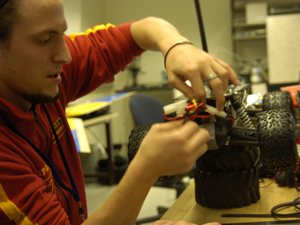Circuits Lab Research Team Enhances Wireless Base Station for the Home
March 2, 2009 / By Tiffany Fox, (858) 246-0353, tfox@ucsd.edu
San Diego, CA, March 2, 2009 — If your mobile phone provider wanted to install a wireless base station in the middle of your living room, you'd probably tell them to take a hike.
|
But what if that base station was only the size of a wireless router? And what if it provided better mobile phone coverage, reduced energy consumption, saved you money and served as an all-in-one, super-fast device that allowed you to share content between electronic gadgets?
Research scientist Don Kimball sees tremendous appeal in such a device, known as a femtocell, or "femto", for short. A femto is a small transceiver connected to a wired network (notably Internet broadband) that makes it possible for mobile communications devices to interact wirelessly. Femtocells can serve an area of about 10 to 100 square meters, as compared to the 1-3 km coverage of a larger macrocell tower.
Kimball is working with a major industry partner to enhance the company's existing femto prototype. "The femto makes service seamless," explains Kimball, a member of the Circuits Lab in the UCSD division of the California Institute for Telecommunications and Information Technology (Calit2). "Seamless connectivity, seamless content sharing. I think this will be very big for the consumer market. Small businesses will catch on fast, and once people realize that this will improve their connectivity and content sharing while saving them money, they'll be very interested in buying one."
He predicts the device — which would support from two to six mobile phones, as well as control cable TV and Internet connections — will be on the market in about 18 months.
|
Kimball and his team — which includes Calit2 programmer analysts Javier Rodriguez Molina, Jeffrey Cuenco and Anthony Nwokafor — have equipped the femtocell with a non-cellular Wi-Fi connection that will allow consumers to control the device from a commercial, Wi-Fi-enabled cell phone. This will also make it possible to share and transport content between devices. With the femto, users could upload videos from their digital cable to a smart phone at a data transfer rate of about 10 Megabits per second. Alternatively, they could use the phone to control a TV or digital video recorder.
The corporate partner approached Kimball with the idea for the project after seeing the Circuit Lab's Gizmo devices, which are technologically sophisticated mobile communications "rovers" that can collect and transmit data in real time. The Gizmos create their own wireless network bubble wherever they go, which is essentially the same idea behind the femtocell prototype.
When a user places a mobile phone call from inside a femto-equipped home, the call is routed through the femtocell rather than through the closest macrocell tower. This improves signal quality, since the user is in closer proximity to the center of coverage. When the user leaves the area covered by the femto, the call is seamlessly transferred to the nearest macrocell tower.
|
Another of the femtocell's merits is its green approach to energy savings. Because it was designed to function in a residential or small business setting, the femto requires no additional cooling power. Cheaper energy bills translate, in turn, to a cheaper digital media package, Kimball says.
"Right now, people are paying about $100 a month for 'all-you-can-eat' data packages that include Internet, digital TV and a telephone land line," he says. "But the femto also communicates over the DSL line. When people start equipping their homes with these devices, what will happen is that one of the media service providers will say, 'How can I compete?' and will add the additional mobile phone service at no extra charge. After all, they don't want you going to another service provider."
In other words, a digital cable provider which offers voice over IP, cable and Internet services could partner with a cellular phone operator. Both would benefit from the others' services, and the package would likely be cheaper, since the mobile providers are saving money by not having to rely on expensive macrocell towers to provide their service.
"Service will go from a triple play to a quadruple play: TV, Internet, mobile service and a land line," Kimball notes. "But really, with this, you wouldn't have to bother with a land line. After all, the connection coming to your home through DSL, so it's not really a 'land' line any more, anyway. You wouldn't need a TiVo set-top box anymore, either, since the Femto would take its place."
|
As for bandwidth, he adds that "femto is new technology but coverage should be better because it's designed better than previous technologies. You can get considerably higher bandwidth, but it depends on the carrier."
Cellular phone companies would also benefit if consumers go the way of the femto since they would no longer be required to lease property for wireless base stations, nor would they be responsible for operating expenses. The cost-savings are also passed on to the consumer, who would no longer be required to pay taxes for use of outside wireless base stations, nor would they be charged for coverage that extends beyond what they really need.
Explains Kimball: "Right now having a cellular base station located somewhere costs the operator money. But what if they could put a base station in your home and charge you? You would pay them for privilege of having one in your home."
Media Contacts
Tiffany Fox, (858) 246-0353, tfox@ucsd.edu


.jpg)


